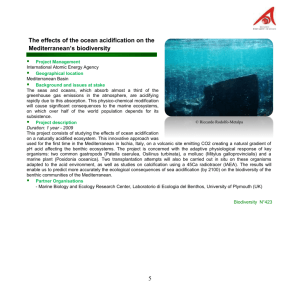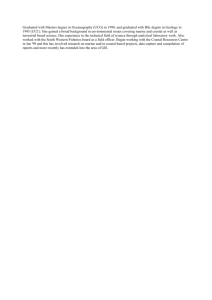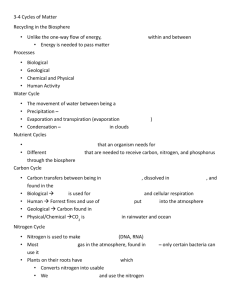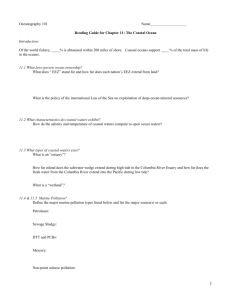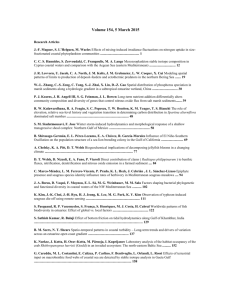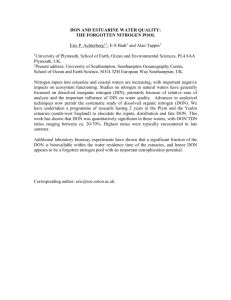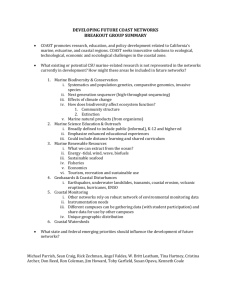5. Nutrient concentration_5october2012
advertisement
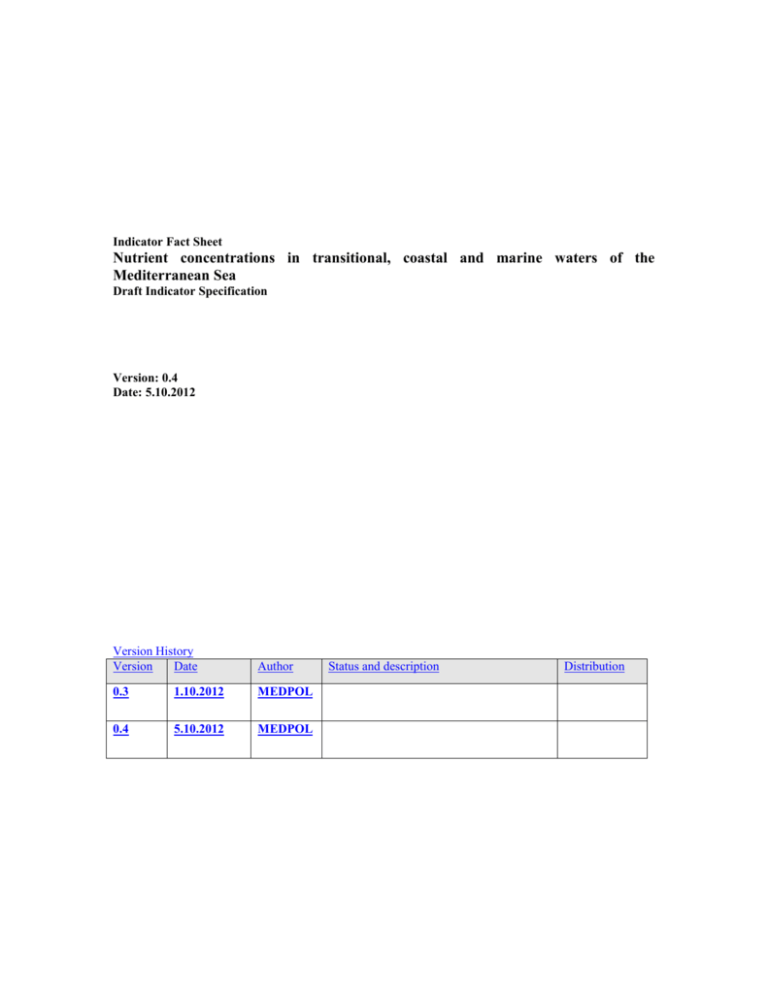
Indicator Fact Sheet Nutrient concentrations in transitional, coastal and marine waters of the Mediterranean Sea Draft Indicator Specification Version: 0.4 Date: 5.10.2012 Version History Version Date Author 0.3 1.10.2012 MEDPOL 0.4 5.10.2012 MEDPOL Status and description Distribution Indicator Specification Indicator Set Date: 05.10.2012 Author (s) MED POL Indicator Title Nutrient concentrations in transitional, coastal and marine waters of the Mediterranean Sea Rationale Justification for indicator selection (namely environmental context) The water quality in transitional and coastal regions could be adversely affected by anthropogenic activities, such as the discharge of untreated sewage, the application of agricultural fertilizers and animal waste, and atmospheric deposition of airborne emissions from shipping and combustion processes. These activities may result in elevated nutrient (nitrogen and phosphorus) concentrations, leading to eutrophication and causing a chain of undesirable effects, including changes in species composition and functioning (such as diatom to flagellate ratio, benthic to pelagic shifts, bloom events of nuisance/toxic algal blooms), reduced water transparency due to an increase in suspended algae, oxygen depletion and noxious odour due to the decay of organic material. The main nutrients causing eutrophication are nitrogen (in the dissolved form of nitrate, nitrite and ammonium) and phosphorus (in the dissolved form of ortho-phosphate that is directly taken up by algae). Since nitrogen and phosphorus may also be bound to sediment particles in organic and inorganic forms with the possibility of returning to the dissolved state, the particulate and organic forms also have to be taken into account. Silicate is essential for diatom growth, but it is assumed that its input is not significantly influenced by human activity. The Mediterranean Sea is one of the most oligotrophic (poor in nutrients) oceanic systems and is characterised by an eastwards longitudinal gradient in oligotrophy. This is due to the exchange between the outflowing deep, relatively nutrient-rich water to the Atlantic and the inflow of superficial, nutrientpoor Atlantic water through the Gibraltar Strait. Another specific characteristic is the high Redfield ratio (N/P ratio), with values ranging from 21 to 27, as compared to the typical ratio of ~ 16 measured in other oceans. This implies that phosphorus is the most important limiting nutrient in the Mediterranean. Although the main body of water of the Mediterranean is characterized by very low nutrient concentrations, some coastal hotspots receive excessive loads of nutrients from sewage effluents, river fluxes, aquaculture farms, fertilizers, and industrial facilities, showing intense eutrophic phenomena with adverse effects for the marine ecosystem and humans. Local productivity is the result of a combination of factors including solar radiation, concentration of nutrients or nutrient gradients in the water column, prevailing meteorological and hydrodynamic conditions. This explains why eutrophication in the Mediterranean is mostly limited to coastal areas, enclosed bays, river estuaries, coastal lagoons or embayments with restricted water exchange with the open sea. Although eutrophication has been more intense in the Northern part of the basin, special attention also has to be paid to the Southern part where the population keeps on growing steadily, agricultural and industrial activities are in rapid development and national legislation is less effective in controlling nutrient enrichment. Scientific references To be revised later M. A. R. Abdel-Moati (1997), Industrial dumping impact on oxygen and nitrogen fluxes in Abu Qir Bay, Southeastern Mediterranean Sea, Environment International, Volume 23, Issue 3, Pages 349-357. G. Arhonditsis, G. Tsirtsis, M. O. Angelidis and M. Karydis (2000), Quantification of the effects of nonpoint nutrient sources to coastal marine eutrophication: applications to a semienclosed gulf in the Mediterranean Sea, Ecological Modelling, Volume 129, Issues 2-3, Pages 209-227. G. Arhonditsis, G. Tsirtsis and M. Karydis (2002), The effects of episodic rainfall events to the dynamics of coastal marine ecosystems: applications to a semi-enclosed gulf in the Meditteranean Sea, Journal of Marine Systems, Volume 35, Issues 3-4, Pages 183-205. M. Astraldi, F. Conversano, G. Civitarese, G. P. Gasparini, M. Ribera d'Alcalà and A. Vetrano (2002), Water mass properties and chemical signatures in the central Mediterranean region, Journal of Marine Systems, Volumes 33-34, Pages 155-177. Y. Azov (1991), Eastern Mediterranean--a marine desert?, Marine Pollution Bulletin, Volume 23, Pages 225-232. Jean P. Béthoux, Pascal Morin and Diana P. Ruiz-Pino (2002), Temporal trends in nutrient ratios: chemical evidence of Mediterranean ecosystem changes driven by human activity, Deep Sea Research Part II: Topical Studies in Oceanography, Volume 49, Issue 11, Pages 2007-2016. J. P. Béthoux, P. Morin, C. Chaumery, O. Connan, B. Gentili and D. Ruiz-Pino (1998), Nutrients in the Mediterranean Sea, mass balance and statistical analysis of concentrations with respect to environmental change, Marine Chemistry, Volume 63, Issues 1-2, Pages 155169. J. P. Bethoux and B. Gentili (1996), The Mediterranean Sea, coastal and deep-sea signatures Indicator definition Main indicator definition This indicator refers to the levels and trends in: nitrate, nitrite, ammonium and ortho-phosphate concentration in transitional, coastal and marine waters of the Mediterranean Sea. NO3 Nitrate is a chemical entity naturally existing in the environment. Other forms in which nitrogen may be made available in the environment are nitrite, ammonium, organic nitrogen, etc. Nitrate, however, is the most stable form in oxidised marine environments. Elemental nitrogen (gas), present everywhere in the atmosphere and dissolved in the seawater, may be converted to one of the other forms by microorganisms in the nitrogen-fixation process andthe reverse is also true, nitrate and other forms of nitrogen may be converted into elemental nitrogen through denitrification. NO2 Nitrite is a chemical entity naturally existing in the environment contributing, as a source of Nitrogen, to the maintenance of the ecosystem. Although free nitrite is toxic to all kinds of higher organisms, marine plants can take it up and some micro-organisms can transform it onto nitrate, ammonium or even nitrogen gas. Nitrite will, eventually, end up contributing to the production of particulate organic matter (POM) and/or dissolved organic matter (DOM). NH4 Ammonium is a chemical entity naturally existing in the environment contributing, as a source of Nitrogen, to the maintenance of the ecosystem. Ammonium is excreted by many organisms, particularly those constituting the zooplankton, and marine plants can take it up even more readily than nitrate or nitrite. Some micro -organisms can transform it onto nitrite, nitrate or even nitrogen gas. Ammonium will, eventually, end up contributing to the production of particulate organic matter (POM) and/or dissolved organic matter (DOM). o-PO4 Orthophosphate is a chemical entity naturally existing in the environment of great importance for the maintenance of the ecosystem since it is required by marine plants and other microorganisms for the production of particulate organic matter (POM) and, eventually, dissolved organic matter (DOM). The Mediterranean Sea has very peculiar conditions when compared to the world’s oceans for having one order of magnitude lower concentrations in the intermediate and deep waters. The Mediterranean Sea also has a higher than normal N/P ratio which makes this sea possibly P-limited instead of N-limited as is considered normal for most oceanic waters Sub-indicator definition The indicator refers to the levels and trends in total nitrogen and total phosphorus concentration in the coastal waters of the Mediterranean Sea. Total nitrogen (TN) comprises the ions nitrate, nitrite and ammonium in the dissolved phase (DIN) and the organic forms of nitrogen (mostly proteins and other N-containing substances) existing in biota and other particulate materials (PON) and in dissolved organic matter (DON). Total nitrogen is not a chemical entity but the methodological addition of the nitrogen equivalent of a number of nitrogen-containing substances. Total nitrogen would comprise the ions nitrate, nitrite and ammonium in the dissolved phase (DIN) and the organic forms of nitrogen (mostly proteins and other N-containing substances) existing in biota and other particulate materials (PON) and in dissolved organic matter (DON). Total phosphorus (TP) comprises the dissolved ion phosphate and the organic forms of phosphorus existing in biota and other particulate materials (POP) and in dissolved organic matter (DOP). Units of main indicators Concentrations in micromol/l Units of sub-indicators Concentrations in micromol/l Policy context and targets Policy context description Various national and international authorities have taken legal and administrative measures to mitigate eutrophication trends in the area, in addition to monitoring. The Mediterranean environment is a good paradigm of integration of extensive legal framework, scientific knowledge and administrative practices. The Barcelona Convention, the Mediterranean Action Plan, and European Union Directives on water quality and coastal management, together with scientific information derived from international research programs in the Mediterranean, provide a sound background for practical actions in eutrophication problems. In 1985, the Contracting Parties to the Barcelona Convention and its LBS Protocol adopted The Genoa Declaration. Amongst the targets approved, one of the priorities was the establishment of sewage treatment plants in all cities around the Mediterranean Sea with more than 100,000 inhabitants and appropriate outfalls and appropriate treatment plants for all cities with more than 10,000 inhabitants. This important target was further agreed in the framework of the Strategic Action programme to combat pollution from land based sources in the Mediterranean (SAP MED) adopted in 1997 by the Contracting parties. In addition, the Contracting Parties in the same framework committed to reduce 50% the nutrient inputs from industrial sources to the Mediterranean sea area by 2010 as well as reduce nutrient inputs from diffuse sources (agriculture and aquaculture) into areas they are likely to cause pollution. In 2009 the Contracting parties adopted the Regional plan (legally binding measures, programmes and timeframes based on Article 15 of the LBS Protocol) with regard to BOD emissions from municipal waste water treatment plants according to which the parties shall ensure that all agglomerations (of more than 2000 p.e and or with economic activities sufficiently concentrated for urban waste water to be collected and treated) to collect and treat their urban wastewaters before discharging them into environment (mainly primary and secondary treatment). Targets The most pertinent regional and national targets with regard to concentrations of nutrients in water arises from the implementation in the Mediterranean will be determined in the framework of UNEP/MAPEcosystem approach roadmap implementation as well as where appropriate in the framework of the EU Water Framework (WFD) and Marine Strategy (MSFD) Directives, where one of the environmental objectives is to achieve good ecological status. The EU Member States have defined water-type specific environmental standards to support the achievement of good ecological status. However there is no yet any agreement of thresholds for nutrients in the WFD for the respective Mediterranean countries (EU member states). As natural and background concentrations of nutrients vary between and within the regional seas, and between types of coastal water bodies, nutrient targets or thresholds for achieving good ecological status have to be determined while taking into account local conditions. Within the scope of the UNEP/MAP Ecosystem approach that is implemented in synergy with the MSFD, nutrient levels (nutrient concentrations in the water column and nutrient ratios for nitrogen, phosphorus and silica, where appropriate), are the relevant indicators in marine waters under Ecological objective: Human-induced eutrophication. The assessment of eutrophication in marine waters needs to combine information on nutrient levels as well as a range of ecologically relevant primary effects and secondary effects, taking into account relevant temporal scales. The nutrient targets and thresholds for achieving good environmental status have not been defined yet and are currently under negotiation by the Contracting parties. Related policy documents UNEP/MAP SAP MED, 1997 Regional Plan on BOD from Waste water treatment plants,2009 Karydis M, Kitsiou D. (2012) Eutrophication and environmental policy in the Mediterranean Sea: A review. Environ Monit Assess. 184(8): 4931-84. Commission Staff Working Paper concerning the relationship between the initial assessment of marine waters and the criteria for good environmental status (SEC(2011) 1255 final) Commission Decision 1 September 2010 on criteria and methodological standards on good environmental status of marine waters (notified under document C(2010) 5956) (2010/477/EU) Policy Summary of Guidance document No. 23 on Eutrophication assessment in the context of European water policies. Common Implementation Strategy for the Water Framework Directive (2000/60/EC) Technical Report 2009-039 Water Framework Directive (WFD) 2000/60/EC: Directive 2000/60/EC of the European Parliament and of the Council of 23 October 2000 establishing a framework for Community action in the field of water policy. Convention for the Protection of the Marine Environment and the Coastal Region of the Mediterranean. Council Directive of 8 December 1975 concerning the Quality of Bathing Water (76/160/EEC) Policy Question(s) Are elevated nutrient concentrations in coastal waters decreasing? Specific policy question (s) (if applicable) Methodology Methodology for indicator calculation (including description of data used) Main indicators Determination of Nitrate: The test for determination of nitrate in seawater (and fresh water as well) consists of a standard photometric technique based on the reduction of nitrate to nitrite with copperised cadmium and then formation of a dye with sulphanilamide and nafthyl-ethylene-diamine. The second step also reacts with nitrite. Usually, nitrite is determined separately by the same technique without the reducing step although, often, the parameter Nitrate includes Nitrite as well. The precision of this technique is very high; however, concentrations in surface waters may be near detection level. Determination of Nitrite: The test for determination of nitrite in seawater (and fresh water as well) consists in a standard photometric technique based on the formation of a dye with sulphanilamide and nafthyl-ethylenediamine. If the procedure starts with the reduction of nitrate, both ions are quantified together. Sometimes, nitrite is determined separately from nitrate although, often, the parameter Nitrate includes Nitrite as well. The precision of this technique is very high; however, concentrations in deeper waters may be near detection level. Determination of Ammonia: The test for determination of ammonium in seawater (and fresh water as well) consists of a standard photometric technique based on the formation of an indophenol dye. The precision of this technique is relatively high; however, concentrations in open sea waters may be near detection level. The technique is subject to laboratory contamination if proper working conditions are not kept. Determination of Ortho-phosphate Standars methods are available. The test for determination of orthophosphate in seawater (and fresh water as well) consists in a standard specific photometric technique based on the reduction of molybdate to molybdenum blue. The precision of this technique is very high, however, concentrations in surface waters are near its detection level. Sub-indicators Determination of Total Nitrogen: The test for determination of total nitrogen in seawater (and fresh water as well) consists in the digestion of the unfiltered sample followed by Kjeldahl (ammonium) or, after oxidation, by the standard photometric technique used for analysis of nitrate. Alternatively, filtering through glass fiber filters allows the concentration of PN which will be submitted to digestion, while the filtrate would be oxidised and submitted to the nitrate analysis. The precision of these techniques is high; however, concentrations in surface waters may be near detection level. Other nitrogen ions and fractions may be analysed, depending on whether the aliquot of water has been previously filtered and/or digested: Dissolved organic Nitrogen (DON) Total Dissolved Nitrogen (DN) Particulate organic Nitrogen (PON) From an environmental point of view, the state in which the nutrient is present in the effluent is quite irrelevant, since the transit from one form to another is readily carried out by one or other kind of the omnipresent micro-organisms. It should be noted that the transformation of organic onto inorganic nutrients (also ammonium onto nitrate) are oxygen-consuming processes dealt with in the BOD test and the particulate form will also contribute to turbidity dealt with elsewhere. No atmospheric deposition of nutrients is monitored by the mediterranean countries. The monitoring of nurients and BOD from municipal wastewater treatment plants have been discontined, so no data are available. However, information on nutrients loads from municipal and industrial sources are available from the NBB database. In addition the 2009 Regional Plan creates the legal basis for establishing a solid and continuous monitoring programme in the near future of municipal waste water quality with regard to BOD content. From a purely technical point of view, it should be stressed that all analytical procedures and techniques should be subject to inter-calibration and quality control protocols. Determination of Total Phosphorus: The test for determination of total phosphorus in seawater (and fresh water as well) consists in the oxidation to phosphate, which is then determined by standard photometric technique. Data Sources Data are generated from the national monitoring programme of the countries in coastal waters Geographical coverage With regard to the atmospheric deposition, there is no regular monitoring. Four locations, two coastal locations in Croatia and another two in Israel with references to other locations in the Mediterranean Sea were included in the research project reported. The entire Mediterranean coastal area was covered by the Municipal wastewater survey. It refers mainly to monitoring the areas at vicinity of pollution sources. Geographical units Local scale, because data are generated from the national monitoring programme of the countries in coastal waters Temporal coverage 2006-2011 (to be confirmed) For some areas, data series exist since 1998. However, there are several countries that do not regularly report on nutrient. Temporal unit: In the current methodology of EEA CSI 021 winter nutrient concentrations for all sea regions are monitored currently under refinement of the temporal unit per sea region. In UNEP/MAP MEDPOL monthly measurements; in case of difficulties 4 samples per year (seasonal) are taken. Statistical aggregation per station and year There is no agreement in MEDPOL on this issue. Yearly mean may be an option. However it has to be discussed and agreed by country experts. Basis for aggregation To be filled in later Trend analysis EEA uses the Mann-Kendall test to compute trends, for which 5 or more years for each station are required. In UNEP/MAP it has to be agreed by experts. Methodology for gap filling Methodology references Data specifications Data references External data references Uncertainties Methodology Uncertainty Data sets uncertainty According to UNEP/MAP MEDPOL data, there is not a statistically significant trend (increasing or decreasing) of nutrients concentrations in coastal water. However, data points are not evenly distributed along the Mediterranean coastline, resulting in important geographical gaps in the available information. Rationale uncertainty Further work Medium-term work Work description Status Deadline Long-term work
